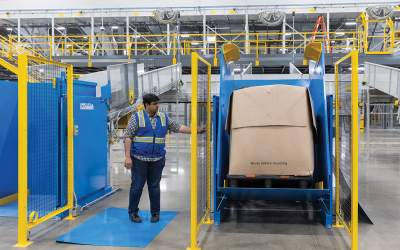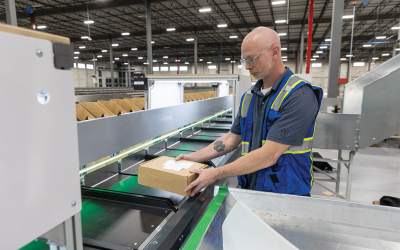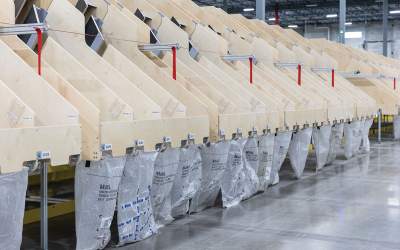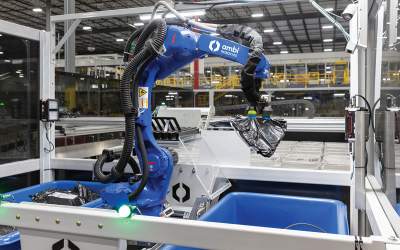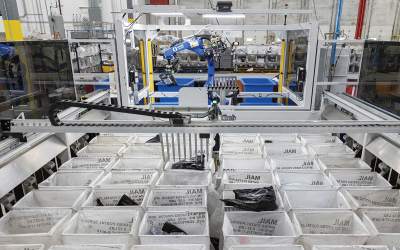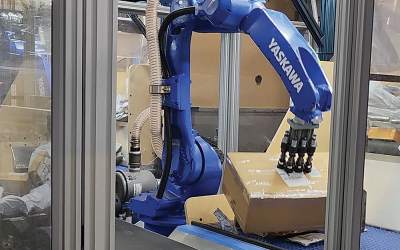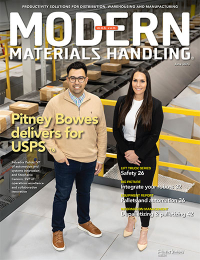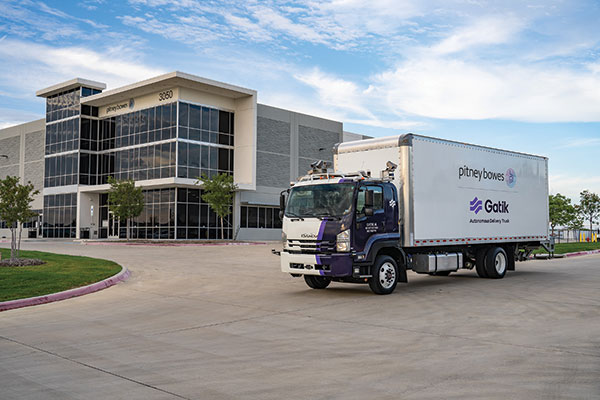Pitney Bowes delivers for USPS
A century-old company embraced automation and robotics in its transformation from a provider of postal meters to an operator of e-commerce parcel sortation centers for the Post Office.
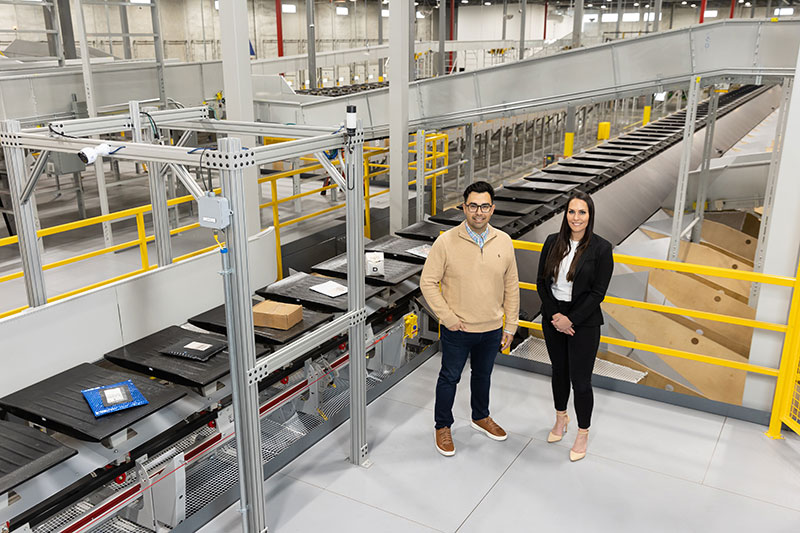
If you think of Pitney Bowes as a mailing meter company, you’d be half right. The company has enjoyed a century-long partnership with the U.S. Postal Service (USPS) and is its largest workshare partner, sorting more than 16 billion pieces of mail each year. But while mail metering and services built the company, it’s only half of Pitney Bowes’ revenue today.
For the past 10 years, Pitney Bowes has been in the midst of a transformation from a company focused on hardware into a true digital and physical parcel shipping company with a network of e-commerce parcel sortation centers that leverage a 100-year-old relationship with the USPS for final-mile delivery. Launched in 2012 with eBay as its sole client, nothing in the way of physical operations and $12 million in revenue, Pitney Bowes Global Ecommerce now serves more than 500 retail and marketplace clients, including eBay and Etsy. In 2022, the new division generated $1.6 billion in revenue, 45% of the company’s total revenue for the year.
Take a closer look at the layout of the new distribution center
Along the way, the organization has developed 14 facilities—and counting—that were “purpose built for B2C e-commerce,” says Stephanie Cannon, senior vice president of operations excellence and collaborative innovation. “Most of our competitors were built for B2B shipping and retrofitted their facilities for B2C e-commerce. We are highly focused on designed delivery services for our customers.” We’ll return to the concept of collaborative innovation in Cannon’s title shortly, as it defines how Pitney Bowes has approached its operations.
When Cannon refers to the facilities as purpose built, she’s not kidding. Pitney Bowes does not store, pick or pack inventory in those facilities. Instead, the network was designed from the ground up for pre-sortation—receiving parcels, sorting them into outbound gaylord containers or postal sacks, and getting them onto an outbound truck—and doing that as optimally and cost-effectively as possible.
That unique focus resulted in two repeatable facility designs: Tier 1 and Tier 2. “The only way for us to build out this many facilities in just three years was to create cookie cutter designs,” says Cannon. “So, every Tier 1 and Tier 2 looks the same.”
A Tier 1 facility, like the new 360,000-square-foot facility recently opened outside of Chicago, is highly automated and designed to process up to 24,000 parcels per hour.
Tier 1 facilities use a mix of conventional automation and emerging technologies. For instance, after bulk unloading, robots from Plus One Robotics induct parcels onto the conveyor and sortation system; from there, parcels are sorted into gaylord containers using Interroll crossbelt or Mantissa tilt tray sorters if the parcels are going to another Pitney Bowes facility, being returned to a customer or to a postal site for a secondary sort.
Other parcels are sorted to EuroSort bomb bay or pushtray sorters that sort parcels directly into postal sacks that will be delivered to a post office for final-mile delivery.
Tier 2 facilities are referred to as “high origin volume locations or final destination locations” that are closer to the end consumer where parcels are sorted into postal sacks for final-mile delivery.
Designed to process 7,000 to 9,000 parcels per hour, Tier 2 facilities automatically weigh, dimension and induct parcels onto an Intralox conveyor before a Hytrol shoe sorter pushes them to the left or the right. From there, most parcels travel to one of eight Ambi Robotics pods, each with 60 postal sacks filled by a gantry robot. Others are sorted by a shoe sorter into gaylords.
In addition to sortation and robotics, Pitney Bowes is piloting autonomous vehicles inside and outside the DCs, including lift trucks using Balyo technology to automatically load gaylord containers onto outbound trucks, and autonomous trucks from Gatik for middle mile deliveries to post office locations.
While the basic design is cookie cutter, continuous improvement is essential to Pitney Bowes approach, notes Salvador Pulido, the vice president of automation and systems innovation.
“The goal is to evaluate what we’ve done in the past, identify pain points and iterate when we build a new facility. We try to stick to our core set of technologies, but we also adapt to the fact that dimension sizes and types of products we handle will vary from one building to another.” - Salvador Pulido
As an example, Pulido points to the introduction of push tray sorters in the new Chicago facility to accommodate new package dimensions.
A century of innovation
On March 15, 1920, the U.S. House of Representatives passed a bill authorizing “mechanical stamps” on First Class mail. One month later, Arthur Pitney and Walter Bowes launched The Pitney-Bowes Postage Meter Company and introduced Pitney’s invention, the Model M Postage Meter. The meter was uni-denominational and printed 2-cent postage. In September of that year, Pitney Bowes became the first postage meter formally approved for use throughout the entire U.S. postal system. More than 100 years later, that partnership is intact.
Over the next 40+ years, the company expanded its product line to add more features facilitating metered mail and expanded its global reach, offering metered mail services to countries around the globe. In 1968, it acquired the Monarch Marking System Company, which produced the first bar code for retail use.
In 2004, Pitney Bowes entered into an agreement with eBay that enabled sellers to print labels for cross-border shipping. Then, in 2012, the company launched the Global Ecommerce business with eBay as its sole client. With no physical operations, the focus was on documentation and information that enabled global commerce and shipping.
Automating the middle mile
At Pitney Bowes, automation doesn’t end at the dock doors. Transportation, the company’s second largest supply chain cost, is a major focus for 2023, according to Stephanie Cannon, senior vice president of operations excellence and collaborative innovation. “As we deal with driver shortages and transportation capacity issues, I started looking at how to use collaborative innovation to drive our operations outside of the four walls,” she recalls.
One of Cannon’s first initiatives is a multi-year agreement signed in August 2022 with Gatik, a provider of autonomous trucks for middle mile logistics. Under the agreement, Gatik will integrate five of its Class 6 autonomous box trucks into the logistics network in Dallas.
The trucks will make multiple deliveries per day between a Pitney Bowes distribution facility to the USPS locations served by the DC. For the first 12 months, a driver will be in the truck; after 12 months, Pitney Bowes anticipates the trucks will be fully autonomous. At the time of this article, the project was scheduled to get underway in the spring of 2023.
Cannon says the partnership with Gatik “promotes growth and accelerates the modernization and expansion of our network with technology solutions that are redefining e-commerce logistics.” She adds that because of federal regulations, which are evolving, it’s likely to be several years out before we see truckload shipments crossing state lines. But the Dallas project is contained to the metropolitan area.
“Right now, we have smaller trucks making multiple trips per day to the same five to 10 post offices to deliver sacks. Every day, the routes are the same, they are repeatable and we don’t cross state lines,” she says. Repeatability and predictability make the market a prime candidate for autonomous trucks, which are supported by Texas.
With Dallas-Fort Worth getting underway, Pitney Bowes is in discussions to expand the partnership in the future, especially in those states that currently allow autonomous trucks.
Five years later, the company jumped into the physical distribution space with the 2017 acquisition for $475 million of Newgistics, another USPS partner. At the time, Pitney Bowes was operating one Global Ecommerce hub, with plans to open another. Meanwhile, Newgistics was processing nearly 100 million parcels for 500 retail partners through nine logistics centers, including more than 50% of all parcel returns select packages shipped by USPS. It also had a national transportation network of more than 50 partners.
The Newgistics acquisition coincided with the growth in e-commerce that continues today. Then came the pandemic.
“That drove even more of a need to accelerate the expansion of these physical nodes and to innovate and build out high-speed automated parcel processing facilities,” Cannon recalls.
The company expanded from 11 parcel handling e-commerce sort centers to 14; included in that was the replacement of the nine facilities from the Newgistics acquisition. There is more to come: The vision is to build a physical transportation network with 20+ locations to process parcels.
The current network includes facilities spanning both coasts, with destinations determined by parcel volumes and population density. Today, those locations include: Seattle; Stockton, Calif.; Ontario, Calif.; Salt Lake City; Dallas; Chicago; Indianapolis; Columbus, Ohio; Hebron, Ky.; Atlanta; Orlando; Baltimore; Newark; and Boston. More facilities are planned for future expansion.
Cannon adds: “The surge drove us to automate and innovate around our largest labor costs tasks as well as the labor shortages given that a lot of warehouse tasks are monotonous, high-turnover jobs.”
To make that happen in a compressed period of time, Cannon and her team sought out “the most innovative technology partners in the world to co-develop new solutions that will improve our service offerings.” The process is known as the Collaborative Innovation Program.
Collaborative innovation
According to Cannon, five high level goals defined the two facility designs:
- Locate the facilities close to the end consumer but also close to the origin volume to reduce transit times.
- Develop the capacity to hit strategic growth goals for processing client parcels. This is measured on throughput and the number of hours a facility can operate in a day.
- Speed within the facilities so parcels enter and exit a facility as fast as possible.
- The flexibility to add solutions as needed to handle a variety of profiles, along with the ability to modify the system quickly if profiles change.
- Finally, unit economics, or the ability to not just execute, but to execute profitably.
To realize those goals, and deliver predictable, reliable and repeatable performance in the warehouses and transportation network, Cannon developed the Collaborative Innovation Program “to differentiate Pitney Bowes with targeted technology and automation themes that solve real problems we are encountering in our warehouse and transportation operations,” she says.
The standard automation platforms are a mix of traditional automated sortation solutions and emerging robotic technologies. Think of it as starting with basic ingredients in a traditional recipe and then jazzing it up with new flavors and seasonings.
“We need a lot of conveyor and a big sortation system, so the starting point for any new building is the core set of technologies in the standard design,” explains Pulido. “But we also know that every building is going to be a little different because the products handled and parcel dimensions are going to be a little different. We try to re-evaluate everything we’ve done in the past so that we keep what’s working and then layer in emerging technologies coming out of our collaborative team.”
To that end, Pitney Bowes has not only worked closely with solution providers familiar to anyone running an automated facility, such as Hytrol, Interroll, Mantissa and EuroSort, but has also introduced new robotic technologies from Plus One Robotics and Ambi Robotics, with more on the drawing board.
Working with robots
While Pulido’s team focuses on traditional automation, the collaborative innovation team focuses on emerging technologies coming out of the start-up community. “These are not science projects,” Cannon says. “We partner with start-ups to develop use cases for real-world problems we’re having in our operations. Then we work collaboratively to design solutions that we can pilot.”
Cannon says the blueprint for the program begins with having automation, innovation development and product teams in place that can scope the level of development needed, the requirements of the project and the length of time to a launch.
With the teams in place, they begin their work by defining a problem that needs to be solved. When a potential partner is identified, the team can then deliver a concise understanding of the need. As the teams begin to work together, they identify the metrics that will define success before a pilot is launched.
During the design process, regular and open communication is made about what is and isn’t working so changes can be made rapidly. Processes are redefined and introduced to get feedback from everyone impacted by the technology.
Finally, a business case is developed that defines the scaled value once the project gets past the pilot stage and is ready to roll out and scale up.
RFPs are typically not used in the Collaborate Innovation Program. Instead, Cannon says, “we go to start-ups that have a solution we think might work. We say to them: Here’s our use case, maybe it’s a monotonous or repetitive job with high turnover. How can we solve this problem together? We always have very well-defined metrics about what we need to get out of it. That helps them develop their products at a fast rate.”
Through the collaborative approach, Pitney Bowes can go from designing a prototype to a pilot in a warehouse to a signed contract for a full-scale rollout in three months or less.
One reason for doing the pilot in a warehouse rather than an innovation center is to involve the line operators who will work with the system early in the process, says Pulido. “We include them as soon as it gets to the pilot stage. That gives our operators a new level of engagement because they see it at its birth.” During the pilot, insights from line operators are used to make changes to the solutions. When it rolls out, they’ve been part of the journey.
The introduction of robotic pods from Ambi Robotics to fill mail sacks is a good example of operator engagement. “We started with one pod in one facility,” Pulido remembers. “With feedback from the onsite teams, and constant iteration and collaboration with Ambi Robotics, we were able to make improvements that allowed us to move forward.” Improvements don’t end with the rollout. “We just made an update to the vision system that was suggested by the operators,” Pulido adds.
The introduction of robotic technologies creates opportunities to upskill the workforce. Some operators who once did repetitive manual induction are now working as higher-skilled robotic operators.
Pitney Bowes opened its newest facility outside of Chicago not long ago, but the company is anything but done. “Now that we’ve introduced robotics, I’m looking at improvements to our vision technology, whether we can use blockchain to bring our data together and looking outside the warehouses to our transportation network,” Cannon says. “We want to be at the forefront of new technologies so we can influence them in a way that differentiates us from our competitors but also allows us to hit our strategic goals.”

Article Topics
Ambi Robotics News & Resources
Ambi Robotics expands partnership with Pitney Bowes to automate middle-mile sorting Pitney Bowes delivers for USPS Sortation and robotics layout at Pitney Bowes Pitney Bowes and Ambi Robotics sign $23 million deployment expansion Ambi Robotics selects DWFritz to manufacture AI-powered robotic systems Ambi Robotics appoints Jim Liefer as CEOLatest in Materials Handling
Geek+ and System Teknik deploy PopPick solution for pharmacy group Med24.dk Beckhoff USA opens new office in Austin, Texas Manhattan Associates selects TeamViewer as partner for warehouse vision picking ASME Foundation wins grant for technical workforce development The (Not So) Secret Weapons: How Key Cabinets and Asset Management Lockers Are Changing Supply Chain Operations MODEX C-Suite Interview with Harold Vanasse: The perfect blend of automation and sustainability Consultant and industry leader John M. Hill passes on at age 86 More Materials HandlingAbout the Author
Subscribe to Materials Handling Magazine

Find out what the world's most innovative companies are doing to improve productivity in their plants and distribution centers.
Start your FREE subscription today.
April 2024 Modern Materials Handling

Latest Resources


